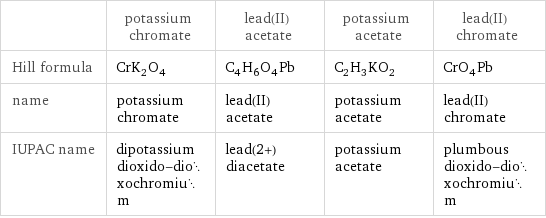Input interpretation

potassium chromate + lead(II) acetate ⟶ potassium acetate + lead(II) chromate
Balanced equation

Balance the chemical equation algebraically: + ⟶ + Add stoichiometric coefficients, c_i, to the reactants and products: c_1 + c_2 ⟶ c_3 + c_4 Set the number of atoms in the reactants equal to the number of atoms in the products for Cr, K, O, C, H and Pb: Cr: | c_1 = c_4 K: | 2 c_1 = c_3 O: | 4 c_1 + 4 c_2 = 2 c_3 + 4 c_4 C: | 4 c_2 = 2 c_3 H: | 6 c_2 = 3 c_3 Pb: | c_2 = c_4 Since the coefficients are relative quantities and underdetermined, choose a coefficient to set arbitrarily. To keep the coefficients small, the arbitrary value is ordinarily one. For instance, set c_1 = 1 and solve the system of equations for the remaining coefficients: c_1 = 1 c_2 = 1 c_3 = 2 c_4 = 1 Substitute the coefficients into the chemical reaction to obtain the balanced equation: Answer: | | + ⟶ 2 +
Structures

+ ⟶ +
Names

potassium chromate + lead(II) acetate ⟶ potassium acetate + lead(II) chromate
Chemical names and formulas

| potassium chromate | lead(II) acetate | potassium acetate | lead(II) chromate Hill formula | CrK_2O_4 | C_4H_6O_4Pb | C_2H_3KO_2 | CrO_4Pb name | potassium chromate | lead(II) acetate | potassium acetate | lead(II) chromate IUPAC name | dipotassium dioxido-dioxochromium | lead(2+) diacetate | potassium acetate | plumbous dioxido-dioxochromium
Substance properties

| potassium chromate | lead(II) acetate | potassium acetate | lead(II) chromate molar mass | 194.19 g/mol | 325.3 g/mol | 98.142 g/mol | 323.2 g/mol phase | solid (at STP) | solid (at STP) | solid (at STP) | solid (at STP) melting point | 971 °C | 280 °C | 304 °C | 844 °C density | 2.73 g/cm^3 | 3.25 g/cm^3 | 1.57 g/cm^3 | 6.023 g/cm^3 solubility in water | soluble | | | surface tension | | | 0.0256 N/m | odor | odorless | | |
Units
